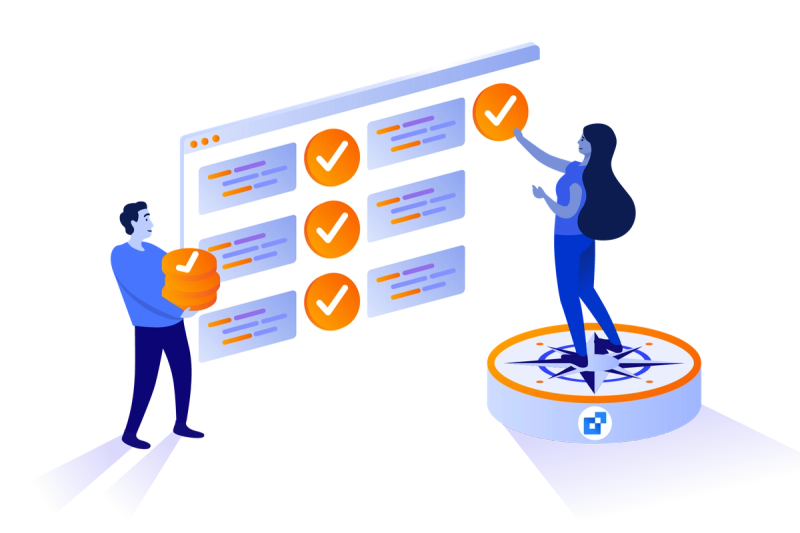Creating empowered and productive autonomous teams with Compass
Share on socials
Creating empowered and productive autonomous teams with Compass

Jason Spriggs
Published on 4 October 2024
5 min read


Jason Spriggs
Published on 4 October 2024
5 min read
In this blog, we'll explore how Compass' team dashboard empowers teams to work autonomously and why that can be beneficial for your organisation.
Nobody likes being micromanaged. In fact, research shows micromanagement is detrimental to performance. It can damage productivity, morale, and motivation, and increase employee turnover. Whereas those who enjoy more freedom tend to perform better, show creativity and innovation, and are more engaged, motivated, and likely to stay with their employer. Given the evidence, it’s not surprising that more organisations today are leaning towards greater autonomy for their employees.
But workplace autonomy extends not only to individuals but to teams as well. As a result, many companies are now organising their employees in autonomous teams. Just like individual autonomy, an autonomous team is one that manages itself with minimum supervision and interference. It makes its own decisions on daily tasks and responsibilities and the creation of work processes to complete those tasks - and tools and software can support teams with this mission.
Atlassian’s Compass—a developer experience platform that can help companies improve software health, reduce cognitive load, and create a better developer experience (DevEx)—features a team dashboard that, through different functionalities, empowers teams to be autonomous. The dashboard gives teams what they need to track the components they own and keep them in a healthy state.
In this blog, we’ll explore how Compass’ team dashboard empowers teams to work autonomously and why that can be beneficial for your organisation. Let’s dig in…
The benefits of autonomous teams
Autonomous teams are usually made up of cross-functional members who are independent, value-aligned, and empowered. By following a flat autonomous structure as opposed to a hierarchical one, each team member is encouraged to be a self-starter rather than a passive participant. This environment promotes an open exchange of ideas and opinions, healthy competition, and proactive collaboration and communication. Plus, decisions can be made more quickly and effectively when the framework is transparent and participatory. You don't need to consult multiple people before making a decision, and this creates a sense of ownership.
Autonomous teams can use software and tools to support the way they work. By implementing software like Compass that empowers autonomous teams, you can create a transparent environment built on trust that promotes ownership.
Compass’ team dashboard
In Compass, your team's dashboard is a launchpad for everything team-related. It provides a central hub for your teams to access information and perform different functions.
Additionally, you can see all pull requests to understand what's in progress and upcoming and quickly identify open pull requests that need review. This helps teams stay on top of their pull requests, deploys, and incidents.
Here are some of the key team-related functions from the dashboard:
- Understand who leads and comprises a team
- View a team's component activity feed
- See scorecard performance at a high level
- Navigate to their Atlassian Teams profile
- View and edit team labels
- Assign a component to the team
- Remove a component from a team’s ownership
- Run CheckOps, a place for your teams to see metrics and goals and write down actions they plan to take
The team dashboard ensures that everyone can work independently and provides an overview of who is working on which software components. It allows engineers to work autonomously by enabling them to link information across Atlassian products and view a team's information, such as their name, description, members, and a list of components they own—essentially, which teams are responsible for which components. This transparency and openness provide visibility into who to contact when incidents occur and can help solve problems faster.
Announcements where they make sense
Compass also brings to the stage a formalised method of communicating out cross-team dependencies, Announcements. When one service needs to communicate something, say a deprecation, planned downtime, or other event that other teams should be aware of, service owners can create announcements to alert other teams to an impending change requiring their attention. This encourages teams to be forthcoming before making changes that could lead to downtime or frustration and similarly helps make other teams feel more confident of their own work, knowing that changes will generally be captured in a proactive fashion.
Empower your teams to achieve more with autonomy
Discover how Compass can transform your development environment into a hub of innovation and collaboration. Contact us today to learn how we can help you build empowered, autonomous teams that drive success.
Read the other blogs in this series

Atlassian Compass: enhancing the developer experience
Explore the challenges of managing complex software environments and how they drain productivity, create security risks, and cause workflow delays.

Customising your developer experience with Compass
Discover how Atlassian's Compass enables custom environments through its extensibility features.
Written by

Consulting Team Lead
Jason, an award-winning DevOps consulting team lead, providing architectural vision and technical expertise. At Adaptavist, Jason and his team implement a wide range of industry-leading technologies and processes for clients.